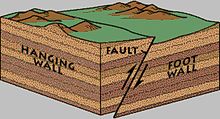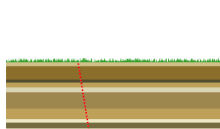Plate tectonics and the structure of the Earth's crust
- See articles on w:Plate tectonics and planetary w:Crust (geology) for more information

The theory of plate tectonics has been around for about 50+ years. It can explain phenomena such as mid oceanic trenches, large-scale volcanic mountain ranges, and earthquakes. But mantle plumes, underwater mountain ranges, geysers etc are harder to explain. As we continue to gather knowledge we could one day get a full picture of how our earth functions and to predict disasters before they happen.
Tectonic Plates
[edit | edit source]A tectonic plate is the crust of the planet that is divided by fault lines, all oceanic and continental rock is part of a tectonic plate down to and including the upper mantle, this is what is known as the lithosphere. Tectonic plates are like the pieces of a jigsaw puzzle, the jigsaw puzzle being the lithosphere. These jigsaw pieces (tectonic plates) differ in their crusts, as some have oceanic and continental crust, while others have only an oceanic crust.
Wait.. what? Oceanic and Continental? What do you mean?
Crusts
[edit | edit source]There are only two crusts.

Continental Crust
[edit | edit source]- Continental Crust - This crust is composed of various types of rocks (igneous, sedimentary, and metamorphic rocks) which is sometimes equated to the word, sial (which are felsic rocks: Rocks that contain a lot of silica), meaning: "Silicon and Aluminum". Sial makes up the majority of continental crusts, which plays a role in its lightness (meaning that the continental crust is lighter than dense, though it is thicker than the Oceanic Crust). The Continental Crust makes up 1/3 of the Earth's surface.
Oceanic Crust
[edit | edit source]- Oceanic Crust - This crust is the part of the Earth's lithosphere that covers up all the ocean basins on Earth. It is the lowest layer, overlying the upper mantle. The Oceanic Crust is mostly compromised of sima, which are mafic rocks (Rocks that have a lot of magnesium and iron in them). Even though the Oceanic Crust is thinner than the Continental Crust, the Oceanic Crust is denser than the Continental Crust (by 0.2 grams per cubic centimeter) due to the minerals in the Oceanic Crust (they are dense because they are made from the plentiful iron, calcium, and magnesium in the Oceanic Crust).
Plate boundary
[edit | edit source]A boundary is defined as a location where plate tectonics "meet". All tectonic plates have boundaries with each other. The boundaries are divided in three categories: Convergent, Divergent, and Transform. How do we figure out which boundary is which? Simply, we have to look at how the plate tectonic plates meet.
The question is: Convergent, Divergent, or Transform? Collide, Separate, or Slide?
Convergent boundary
[edit | edit source]
A Convergent Boundary is a section of a plate that is moving towards another plate, and collides with it. A good example is the Indian plate moving north into the Eurasian plate, forming the Himalayas. There are three types of plate convergence.
- Oceanic-Oceanic convergence: where the colder denser plate sub-ducts (meaning it one plate moves under another plate) under the other less dense plate (Pacific plate sub-ducting under the Australian plate north of New Zealand, but the Australian plate does sub-duct under the pacific plate in other areas).
- Oceanic-continental: where the oceanic plate sub-ducts under the continental plate (Nazca plate sub-ducting under the South American plate).
- Continental-continental convergence (Indian plate is moving north wile the Eurasian plate is moving south).
Divergent boundary
[edit | edit source]
This is where two or more plates are separating and moving in different directions. At the center of the dividing plates is called a rift. A rift is an area where [a] tectonic plate(s) has(ve) started to divide into two. New sea floor forms from this boundary. Mid-ocean ridges (Underwater mountain rage formed by divergent boundary) are the most common type of divergent boundary.
Transforming boundary
[edit | edit source]
These type of plates are moving past each other, they are the least numerous of the plate boundaries, but as in the San Andreas fault, can be quite devastating. The places where these boundaries take place are called faults, which leads to earthquakes. This is because the tectonic plates have abnormal edges, resulting in a lot of jerking, sliding, and basically, violent shakes. So, when these plates slide past each other, they violently move, causing earthquakes.
Faults
[edit | edit source]Faults are a response to stress on the surface when rocks break and move. Blocks surrounding the sides of the faults are called fault blocks. In horizontal faults, the hanging wall and the footwall become reality. The position of a fault block determines whether a block of rock is a footwall or a hanging wall. It is essential to know what the hanging wall and the footwall is/and how it looks to determine which fault is which.
To determine the type of fault, we need to know the relationship between the hanging wall and the footwall in the fault, if the hanging wall and the footwall are going through a compression, or going through a tension.
Normal Faults
[edit | edit source]

Normal Faults happen when the hanging wall moves down while the foot wall moves up. Normal faults form when rocks go through a type of deformation (When the shape of a rock changes due to stress) called tension. Tension is when a force acts to stretch out an object. For example, if you cause tension to a piece of paper, the paper will rip. Similarly, in a normal fault, tectonic forces stretch out and pull apart rocks.
Reverse Faults
[edit | edit source]

Reverse Faults happen when the rocks are pushed together by a type of deformation called compression. Compression is when tectonic forces push rocks together. When compression acts on rocks, reverse faults form, causing the hanging wall to move up relative to the footwall moving down.

Strike Slip Faults
[edit | edit source]
These faults are the 3rd major type of faults, where opposing forces move rocks horizontally. If you were to place two identical rocks on each side of the rock in a strike-slip fault, both of them would move in opposite directions. Some examples of Strike-Slip Faults are the San Andreas Fault, California and Anatolian Fault, Turkey. Both faults are causes of some great and devastating earthquakes, such as the 1999 İzmit earthquake in Turkey (over 15,000+ people killed) and the 1906 San Francisco earthquake that destroyed 80% of the San Francisco area.
Folds
[edit | edit source]

Folding is when two pieces of plates collide/separate. An example of this is a piece of bread. Take a flexible piece of bread, and push them together. Notice something? The middle part of the bread has a bulge. This is similar to what happens on earth. Obviously, there will be high and lows points in the folding of the Earth.
The upward arching in a fold is called the anticline. Some examples are of the El Darado Anticline in Kansas, USA, and another example is this: https://www.google.com/search?q=El+Dorado+anticline&source=lnms&tbm=isch&sa=X&ved=0ahUKEwj_tKTbpMDRAhWGJiYKHdFfC4cQ_AUICCgB&biw=1366&bih=662&safe=active&ssui=on#imgrc=wakhcZ3svMPA9M%3A. This anticline is in a road cut.
The downward fold is called a syncline. Some examples of synclines are listed here: http://facweb.bhc.edu/academics/science/harwoodr/GEOL101/Study/Images/D042-492.jpg - Syncline near Hurricane, Utah.
The fold that contains rock layers which are horizontally folded in different levels is called a monocline. For examples of monoclines: http://facweb.bhc.edu/academics/science/harwoodr/GEOL101/Study/Images/D040-0390.jpg - Arizona; http://facweb.bhc.edu/academics/science/harwoodr/GEOL101/Study/Images/D040-0807.jpg - Arizona

Mountains
[edit | edit source]Defined as: "Mountains are the wrinkles of age and pimples of youth on Earth's crusty outer skin. They rise up as the crust collides, cracks, crumbles, folds, and spews. By definition, they dominate their surroundings with towering height" - according to National Geographic on Mountains. When plate tectonics compress or do a "tense", they can form majestic mountains. Let's explore into the three most common types of mountains.
Folded Mountains
[edit | edit source]The highest mountain ranges are called Folded Mountains. Folded Mountains form when rock layers are compressed and push up, or in other words, form at a convergent boundary (where plate tectonics collide with each other). Hold a stack of noodles in your hands horizontally, and squeeze them together to the point they have a bulge in the middle. This is, similarly, what causes Folded Mountains to form.
Fault-Block Mountains
[edit | edit source]Fault-Block Mountains form when tectonic forces put enough tension (pulling away type of force) to the Earth's crust that cause a great number of faults to form. When tension causes blocks of the Earth to collapse/move away to a position relative to other blocks, fault-block mountains form. Some parts of the Earth's crust goes up and some goes down (raise and decrease in elevation). These forces tend to, after this tremendous pressure that is being forced on Earth's crust, form mountains. Mountains so famous and majestic like the Sierra Nevada Mountains.
Volcanic Mountains
[edit | edit source]Majority of active Volcanic Mountains are active in the rim of the Pacific Ocean. This place is known as the Ring of Fire. These volcanic mountains are located at convergent boundaries, where denser ocean crust sinks into the asthenonsphere at subduction zones. The rock that has fallen into the asthenonsphere forms magma after being melted in the subduction zone, in which then the magma rises to the Earth's surface and erupts. This forms the volcanic mountains we know of today.
Readings
[edit | edit source]Sedimentary rocks
- http://earthds.info/pdfs/EDS_05.PDF Sedimentary rocks.
- http://danling.com/earthling/geo/Chapter%206%20Outline%20-%20Sedimentary%20Rocks.pdf
Igneous rock
- http://earthds.info/pdfs/EDS_04.pdf Igneous rocks
- http://msnucleus.org/membership/html/jh/earth/igneous/jhigneous.pdf Igneous rocks 2
Metamorphic rock
- http://earthds.info/pdfs/EDS_06.PDF Metamorphic rocks
Resources
[edit | edit source]- Layers of the Earth
- Perspectives on Ocean Science: Geology in Your Backyard by Dr. Neal Driscoll, youtube video 56:07 minutes long
- Sumatran plate boundry at Caltech
- Plate boundry processes- UTIG
- Geology AS 2: Rocks
External Links
[edit | edit source]- Google Map of The Topography of Plate Tectonics - Zoom in close on the volcanoes, hydrothermal vents, surmounts, submarine fracture zones and mid-ocean ridges that comprise the plate edges.
